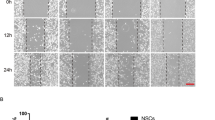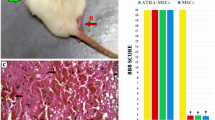Abstract
Clinical translation of growth factor therapies faces multiple challenges; the most significant one is the short half-life of the naked protein. Gelatin nanostructured lipid carriers (GNLs) had previously been used to encapsulate the basic fibroblast growth factor to enhance the functional recovery in hemiparkinsonian rats. In this research, we comparatively study the enhanced therapy between nerve growth factor (NGF) loaded GNLs (NGF-GNLs) and NGF only in spinal cord injury (SCI). The effects of NGF-GNLs and NGF only were tested by the Basso-Beattie-Bresnahan (BBB) locomotion scale, inclined plane test, and footprint analysis. Western blot analysis and immunofluorescent staining were further performed to identify the expression of ER stress-related proteins, neuron-specific marker neuronal nuclei (NeuN), and growth-associated protein 43 (GAP43). Correlated downstream signals Akt/GSK-3β and ERK1/2 were also analyzed with or without inhibitors. Results showed that NGF-GNLs, compared to NGF only, enhanced the neuroprotection effect in SCI rats. The ER stress-induced apoptosis response proteins CHOP, GRP78 and caspase-12 inhibited by NGF-GNL treatment were more obvious. Meanwhile, NGF-GNLs in the recovery of SCI are related to the inhibition of ER stress-induced cell death via the activation of downstream signals PI3K/Akt/GSK-3β and ERK1/2.






Similar content being viewed by others
References
Tator CH (2006) Review of treatment trials in human spinal cord injury: issues, difficulties, and recommendations. Neurosurgery 59:957–982
Penas C, Guzman MS, Verdu E, Fores J, Navarro X, Casas C (2007) Spinal cord injury induces endoplasmic reticulum stress with different cell-type dependent response. J Neurochem 102:1242–1255
Li GL, Brodin G, Farooque M, Funa K, Holtz A, Wang WL, Olsson Y (1996) Apoptosis and expression of Bcl-2 after compression trauma to rat spinal cord. J Neuropathol Exp Neurol 55:280–289
Katoh K, Ikata T, Katoh S, Hamada Y, Nakauchi K, Sano T, Niwa M (1996) Induction and its spread of apoptosis in rat spinal cord after mechanical trauma. Neurosci Lett 216:9–12
Ron D, Walter P (2007) Signal integration in the endoplasmic reticulum unfolded protein response. Nat Rev Mol Cell Biol 8:519–529
Zhang HY, Wang ZG, Lu XH, Kong XX, Wu FZ, Lin L, Tan X, Ye LB et al (2015) Endoplasmic reticulum stress: relevance and therapeutics in central nervous system diseases. Mol Neurobiol 51:1343–1352
Kim I, Xu W, Reed JC (2008) Cell death and endoplasmic reticulum stress: disease relevance and therapeutic opportunities. Nat Rev Drug Discov 7:1013–1030
Soboloff J, Berger SA (2002) Sustained ER Ca2+ depletion suppresses protein synthesis and induces activation-enhanced cell death in mast cells. J Biol Chem 277:13812–13820
Ding W, Yang L, Zhang M, Gu Y (2012) Reactive oxygen species-mediated endoplasmic reticulum stress contributes to aldosterone-induced apoptosis in tubular epithelial cells. Biochem Biophys Res Commun 418:451–456
Liu XD, Ko S, Xu Y, Fattah EA, **ang Q, Jagannath C, Ishii T, Komatsu M et al (2012) Transient aggregation of ubiquitinated proteins is a cytosolic unfolded protein response to inflammation and endoplasmic reticulum stress. J Biol Chem 287:19687–19698
Larner SF, Hayes RL, Wang KK (2006) Unfolded protein response after neurotrauma. J Neurotrauma 23:807–829
Schroder M, Kaufman RJ (2005) The mammalian unfolded protein response. Annu Rev Biochem 74:739–789
Yang D, Han Y, Zhang J, Chopp M, Seyfried DM (2012) Statins Enhance Expression of Growth Factors and Activate the PI3K/Akt-mediated Signaling Pathway after Experimental Intracerebral Hemorrhage. World J Neurosci 2:74–80
Zhang Z, Tong N, Gong Y, Qiu Q, Yin L, Lv X, Wu X (2011) Valproate protects the retina from endoplasmic reticulum stress-induced apoptosis after ischemia-reperfusion injury. Neurosci Lett 504:88–92
Ohri SS, Maddie MA, Zhao Y, Qiu MS, Hetman M, Whittemore SR (2011) Attenuating the endoplasmic reticulum stress response improves functional recovery after spinal cord injury. Glia 59:1489–1502
Valenzuela V, Collyer E, Armentano D, Parsons GB, Court FA, Hetz C (2012) Activation of the unfolded protein response enhances motor recovery after spinal cord injury. Cell Death Dis 3:e272
Kishi S, Shimoke K, Nakatani Y, Shimada T, Okumura N, Nagai K, Shin-Ya K, Ikeuchi T (2010) Nerve growth factor attenuates 2-deoxy-d-glucose-triggered endoplasmic reticulum stress-mediated apoptosis via enhanced expression of GRP78. Neurosci Res 66:14–21
Zhao YZ, Li X, Lu CT, Lin M, Chen LJ, **ang Q, Zhang M, ** RR et al (2014) Gelatin nanostructured lipid carriers-mediated intranasal delivery of basic fibroblast growth factor enhances functional recovery in hemiparkinsonian rats. Nanomedicine 10:755–764
Zhang C, Chen J, Feng C, Shao X, Liu Q, Zhang Q, Pang Z, Jiang X (2014) Intranasal nanoparticles of basic fibroblast growth factor for brain delivery to treat Alzheimer’s disease. Int J Pharm 461:192–202
Zhang HY, Wang ZG, Wu FZ, Kong XX, Yang J, Lin BB, Zhu SP, Lin L et al (2013) Regulation of autophagy and ubiquitinated protein accumulation by bFGF promotes functional recovery and neural protection in a rat model of spinal cord injury. Mol Neurobiol 48:452–464
Basso DM, Beattie MS, Bresnahan JC (1995) A sensitive and reliable locomotor rating scale for open field testing in rats. J Neurotrauma 12:1–21
Rivlin AS, Tator CH (1977) Objective clinical assessment of motor function after experimental spinal cord injury in the rat. J Neurosurg 47:577–581
de Medinaceli L, Freed WJ, Wyatt RJ (1982) An index of the functional condition of rat sciatic nerve based on measurements made from walking tracks. Exp Neurol 77:634–643
Szegezdi E, Herbert KR, Kavanagh ET, Samali A, Gorman AM (2008) Nerve growth factor blocks thapsigargin-induced apoptosis at the level of the mitochondrion via regulation of Bim. J Cell Mol Med 12:2482–2496
Mantilla CB, Gransee HM, Zhan WZ, Sieck GC (2013) Motoneuron BDNF/TrkB signaling enhances functional recovery after cervical spinal cord injury. Exp Neurol 247:101–109
Sasaki M, Radtke C, Tan AM, Zhao P, Hamada H, Houkin K, Honmou O, Kocsis JD (2009) BDNF-hypersecreting human mesenchymal stem cells promote functional recovery, axonal sprouting, and protection of corticospinal neurons after spinal cord injury. J Neurosci 29:14932–14941
Ansorena E, De Berdt P, Ucakar B, Simon-Yarza T, Jacobs D, Schakman O, Jankovski A, Deumens R et al (2013) Injectable alginate hydrogel loaded with GDNF promotes functional recovery in a hemisection model of spinal cord injury. Int J Pharm 455:148–158
Zhao YZ, Tian XQ, Zhang M, Cai L, Ru A, Shen XT, Jiang X, ** RR et al (2014) Functional and pathological improvements of the hearts in diabetes model by the combined therapy of bFGF-loaded nanoparticles with ultrasound-targeted microbubble destruction. J Control Release 186:22–31
Layman H, Spiga MG, Brooks T, Pham S, Webster KA, Andreopoulos FM (2007) The effect of the controlled release of basic fibroblast growth factor from ionic gelatin-based hydrogels on angiogenesis in a murine critical limb ischemic model. Biomaterials 28:2646–2654
Ullm S, Kruger A, Tondera C, Gebauer TP, Neffe AT, Lendlein A, Jung F, Pietzsch J (2014) Biocompatibility and inflammatory response in vitro and in vivo to gelatin-based biomaterials with tailorable elastic properties. Biomaterials 35:9755–9766
Ogawa S, Kitao Y, Hori O (2007) Ischemia-induced neuronal cell death and stress response. Antioxid Redox Signal 9:573–587
DeGracia DJ, Montie HL (2004) Cerebral ischemia and the unfolded protein response. J Neurochem 91:1–8
Dumont RJ, Okonkwo DO, Verma S, Hurlbert RJ, Boulos PT, Ellegala DB, Dumont AS (2001) Acute spinal cord injury, part I: pathophysiologic mechanisms. Clin Neuropharmacol 24:254–264
Park E, Velumian AA, Fehlings MG (2004) The role of excitotoxicity in secondary mechanisms of spinal cord injury: a review with an emphasis on the implications for white matter degeneration. J Neurotrauma 21:754–774
Dang AB, Tay BK, Kim HT, Nauth A, Alfonso-Jaume MA, Lovett DH (2008) Inhibition of MMP2/MMP9 after spinal cord trauma reduces apoptosis. Spine (Phila Pa 1976) 33:E576–579
Chen KB, Uchida K, Nakajima H, Yayama T, Hirai T, Watanabe S, Guerrero AR, Kobayashi S et al (2011) Tumor necrosis factor-alpha antagonist reduces apoptosis of neurons and oligodendroglia in rat spinal cord injury. Spine (Phila Pa 1976) 36:1350–1358
Kim JS, Heo RW, Kim H, Yi CO, Shin HJ, Han JW, Roh GS (2014) Salubrinal, ER stress inhibitor, attenuates kainic acid-induced hippocampal cell death. J Neural Transm 121:1233–43
Wang HJ, Cao JP, Yu JK, Zhang LC, Jiang ZJ, Gao DS (2008) Calbindin-D28K expression induced by glial cell line-derived neurotrophic factor in substantia nigra neurons dependent on PI3K/Akt/NF-kappaB signaling pathway. Eur J Pharmacol 595:7–12
Wuhanqimuge IA, Matsuki Y, Tanaka M, Arioka M (2013) Lysophosphatidylcholine enhances NGF-induced MAPK and Akt signals through the extracellular domain of TrkA in PC12 cells. FEBS Open Bio 3:243–251
Dal-Cim T, Molz S, Egea J, Parada E, Romero A, Budni J, Martin de Saavedra MD, del Barrio L et al (2012) Guanosine protects human neuroblastoma SH-SY5Y cells against mitochondrial oxidative stress by inducing heme oxigenase-1 via PI3K/Akt/GSK-3beta pathway. Neurochem Int 61:397–404
Zhang HY, Zhang X, Wang ZG, Shi HX, Wu FZ, Lin BB, Xu XL, Wang XJ et al (2013) Exogenous basic fibroblast growth factor inhibits ER stress-induced apoptosis and improves recovery from spinal cord injury. CNS Neurosci Ther 19:20–29
Wang Z, Zhang H, Xu X, Shi H, Yu X, Wang X, Yan Y, Fu X et al (2012) bFGF inhibits ER stress induced by ischemic oxidative injury via activation of the PI3K/Akt and ERK1/2 pathways. Toxicol Lett 212:137–146
Acknowledgments
This work was supported by the Zhejiang Provincial Program for the Cultivation of High-Level Innovative Health talents (to J. X), National Natural Science Funding of China (81372112, 81200958, 81302775), Zhejiang Natural Science Funding (Y14H170008), State Key Basic Research Development Program (2012CB518105), Ningbo Natural Science Foundation (2012A610255), and Zhejiang undergraduate talent project (2014R413067).
Conflict of Interest
The authors declare no conflict of interest.
Statement on the Welfare of Animals
All applicable international, national, and/or institutional guidelines for the care and use of animals were followed. All procedures performed in studies involving animals were in accordance with the ethical standards of the institution or practice at Wenzhou Medical University. This article does not contain any studies with human participants performed by any of the authors.
Author information
Authors and Affiliations
Corresponding authors
Additional information
Si-Pin Zhu, Zhou-Guang Wang and Ying-Zheng Zhao contributed equally to this work.
Rights and permissions
About this article
Cite this article
Zhu, SP., Wang, ZG., Zhao, YZ. et al. Gelatin Nanostructured Lipid Carriers Incorporating Nerve Growth Factor Inhibit Endoplasmic Reticulum Stress-Induced Apoptosis and Improve Recovery in Spinal Cord Injury. Mol Neurobiol 53, 4375–4386 (2016). https://doi.org/10.1007/s12035-015-9372-2
Received:
Accepted:
Published:
Issue Date:
DOI: https://doi.org/10.1007/s12035-015-9372-2




